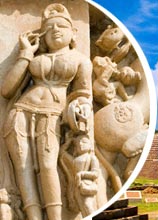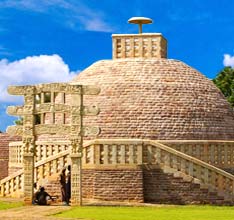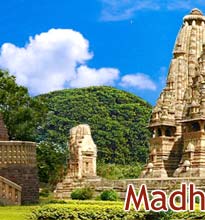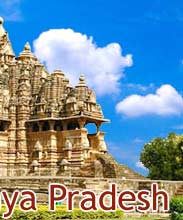 A
land that inspired Rudyard Kipling to write his classic novel 'Jungle
Book', the forested areas of Kanha, with their wild thickets of sal and
bamboo forests, rolling meadows and dramatic ravines, are home to the
Kanha National Park. The Created in 1955, the national park is today the
core area of the Kanha Tiger Reserve, which came into being in 1974,
under Project Tiger. The Banjar and the Halon valley form the two halves
constituting the vast stretches of land that is the Kanha Tiger Reserve.
A
land that inspired Rudyard Kipling to write his classic novel 'Jungle
Book', the forested areas of Kanha, with their wild thickets of sal and
bamboo forests, rolling meadows and dramatic ravines, are home to the
Kanha National Park. The Created in 1955, the national park is today the
core area of the Kanha Tiger Reserve, which came into being in 1974,
under Project Tiger. The Banjar and the Halon valley form the two halves
constituting the vast stretches of land that is the Kanha Tiger Reserve.One of the greatest achievements of this park is perhaps its contribution in saving many endangered wildlife species, which nearly bordered extinction. The park today steadfastly guards the different genus of wildlife it domiciles and follows painstaking measures to maintain the overall protection of its flora, fauna and avifauna. The popular 'Sunset Point' or 'Bamni Dadar' inside the park is the best lookout point that allows visitors to soak the beautiful landscape of the park and relish rare sights of wildlife viewing.
Wildlife
Trailing a wild tiger lazing around the shades of the forests of Kanha offers its own charm. In fact, the tigers remain the most exciting draw of the place. The park is also home to Sambars and Gaurs, which are generally seen in the green meadows, grazing away the grasses to glory. Animals like blackbuck and chital are also common sights. Other main wildlife attractions of the park include bison, barasingha, barking deer, black deer, chousingha, nilgai, mouse deer, sloth bear, jackal fox, porcupine, hyena, jungle cat, python, mongoose, and leopard.
Avifauna
Apart from the many species of animals that contribute to the wealth of fauna of this jungled beauty, one can also notice a wide variety of exotic birds here. Avifauna of the park include bird species like storks, peacocks, teals, pintails, pond herons, egrets, pea fowl, jungle fowl, spur fowl, papihas, partridges, ring doves, quails, spotted parakeets, green pigeons, rock pigeons, cuckoos, rollers, bee-eater, hoopoes, drongos, warblers, kingfishers, woodpeckers, finches, orioles, owls, and fly catchers. Thus, the place is indeed an ornithological wonder and a paradise for all bird watchers.
Some More Information
The park falls under a climatic zone that is tropical. Summers remain hot and humid with a maximum and minimum temperature of 40.6°C and 23.9°C. Winters are bracing with an average maximum and minimum temperature of 23.9°C and 11.1°C. Thus, the best time to visit the park is either between April and June, or between November and January. The place can be easily reached by air, road or rail from Jabalpur (169 km).










